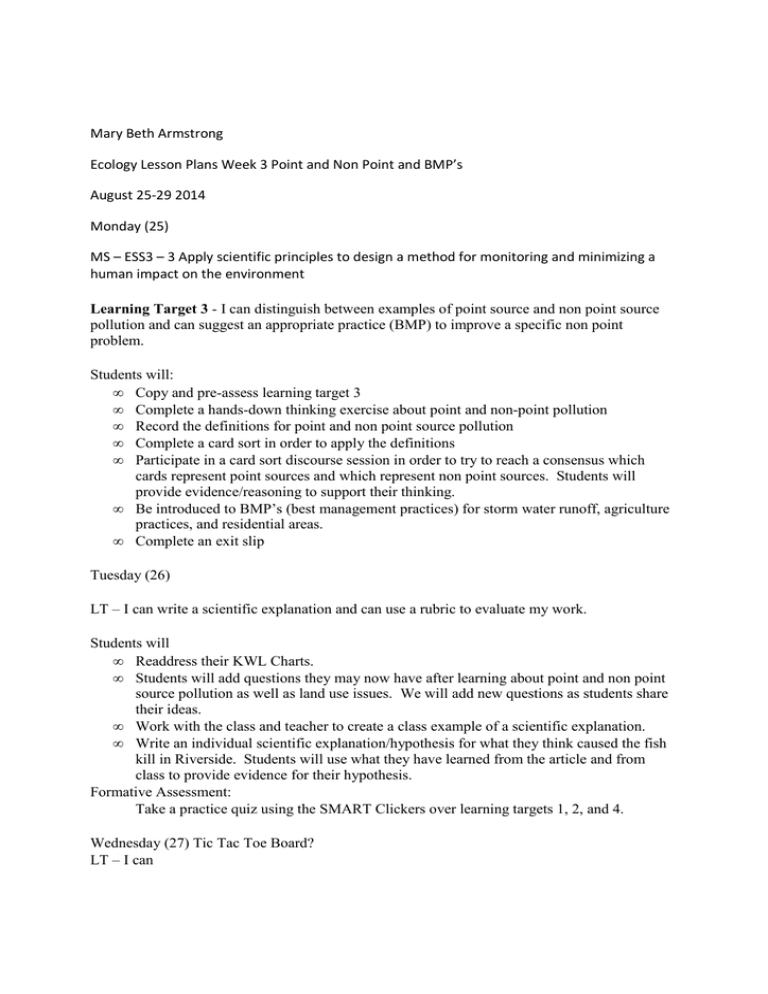Mary Beth Armstrong August 25-29 2014 Monday (25)
advertisement

Mary Beth Armstrong Ecology Lesson Plans Week 3 Point and Non Point and BMP’s August 25-29 2014 Monday (25) MS – ESS3 – 3 Apply scientific principles to design a method for monitoring and minimizing a human impact on the environment Learning Target 3 - I can distinguish between examples of point source and non point source pollution and can suggest an appropriate practice (BMP) to improve a specific non point problem. Students will: • Copy and pre-assess learning target 3 • Complete a hands-down thinking exercise about point and non-point pollution • Record the definitions for point and non point source pollution • Complete a card sort in order to apply the definitions • Participate in a card sort discourse session in order to try to reach a consensus which cards represent point sources and which represent non point sources. Students will provide evidence/reasoning to support their thinking. • Be introduced to BMP’s (best management practices) for storm water runoff, agriculture practices, and residential areas. • Complete an exit slip Tuesday (26) LT – I can write a scientific explanation and can use a rubric to evaluate my work. Students will • Readdress their KWL Charts. • Students will add questions they may now have after learning about point and non point source pollution as well as land use issues. We will add new questions as students share their ideas. • Work with the class and teacher to create a class example of a scientific explanation. • Write an individual scientific explanation/hypothesis for what they think caused the fish kill in Riverside. Students will use what they have learned from the article and from class to provide evidence for their hypothesis. Formative Assessment: Take a practice quiz using the SMART Clickers over learning targets 1, 2, and 4. Wednesday (27) Tic Tac Toe Board? LT – I can Students will be introduced to a Tic Tac Toe Choice Project Board. I will spend a few minutes showing examples to students. I will give each child a Choice Board and will show them my web page which contains links to each individual project. Students can access information/resources on my web page. Due dates and rubrics for the first project will be discussed. Thursday (28) LT – I can define invasive species, identify a problem associated with invasive species, and can identify a strategy that could be used to slow down the spread of invasive species in the United States after reading an article about invasive species in Kentucky. Students will • Jot down invasive species that they have heard about in the United States; Pair/Share • Watch a video clip about the spread of invasive species across the U.S. • Read an article on invasive species in Kentucky. • Use information from the article to complete a 4-Thought Organizer. • Discuss the Organizer • Watch a video clip about invasive plant species in the U. S. • Use a writer’s frame to create a summary about invasive species. Video links can be found on my webpage or at the following web address: http://www.rowan.kyschools.us/olc/page.aspx?id=19077&s=994 Friday (29) LT – I can navigate an interactive website in order to define the Gulf Dead Zone, determine the causes of the Dead Zone, and can identify who is affected by it. Students will • Create fist list in order to review the Invasive Species article they read yesterday. • Review a River Runs Through It and BMP’s lesson. Discuss how everything that happens upstream in the Licking affects the Ohio and everything that effects the Ohio effects the Mississippi. Ultimately the way we use land impacts the Gulf of Mexico. • Use Ipads to investigate the Gulf Dead Zone. Formative Assessment: Students will complete a short formative quiz to evaluate whether they learned the main points presented on the Dead Zone site. http://www.smm.org/deadzone/top.html




